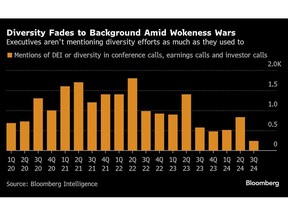Article content
(Bloomberg) — Women are increasingly being hired for the roles at companies that tend to lead to the CEO slot, but they’re still largely missing at the highest rungs of British corporations.
New research shows that the path for women to become CEO remains “unbelievably narrow” across British corporations.

(Bloomberg) — Women are increasingly being hired for the roles at companies that tend to lead to the CEO slot, but they’re still largely missing at the highest rungs of British corporations.
Article content
Article content
Women now make up 23% of chief financial officers, chief operating officers, divisional bosses or are already chief executives across the FTSE 100, according to new research by 25×25, an organization formed to help boost the level of female talent at the top of British companies. That’s up from 16% in 2021, the group said.
Advertisement 2
Story continues below
Article content
The increase is important, the organization found, because 90% of the CEOs of the country’s biggest companies came up through one of those roles. Still, just two out of 17 CEO appointments in the FTSE 100 between June 2023 and June 2024 were women.
The research shows just how much of an uphill battle female executives have. Even today, just nine of the FTSE 100 bosses are women, down from a peak of 11 the index reached earlier this year.
Learn More: Bloomberg to Host Inaugural Women, Money & Power Event
“The pathways to CEO are unbelievably narrow,” said Tara Cemlyn-Jones, a former investment banker who now leads 25×25. “The great majority have developed their skills and experience in narrow silos.”
Cemlyn-Jones – whose organization includes public and private companies from different sectors, including NatWest Group Plc, BP Plc, Unilever Plc and BAE Systems Plc – encouraged corporations to take a more flexible approach to candidates’ experience, which she believes would allow more women reach the top.
To be sure, the UK isn’t alone. Separate research from Bloomberg Intelligence has found that globally, only 6% of CEOs are women, with the level ranging from 3% in emerging markets to 8% in the US and Europe.
Article content
Advertisement 3
Story continues below
Article content
“Women have made scant progress in the C-Suite,” said Adeline Diab, director of research and chief ESG strategist at Bloomberg Intelligence. “Three in four companies still have no women in C-Suite positions.”
35% of leadership positions are held by women, according to this year’s FTSE Women Leaders Review of the top 350 companies across the UK – though that figure “masks the truth,” said Pavita Cooper, UK chair of the 30% Club, which campaigns for more women on boards. Not enough of those women are in charge of significant parts of the business which would put them on a route to the CEO role, she said.
Part of the problem is that some stakeholders — such as board members and head hunters — are an “inadvertent drag” on more women reaching the CEO rank and are instead prompting boards to appoint people who are similar to the incumbent executive holding the role, Cemlyn-Jones said.
“I think boards in the UK are becoming more and more risk averse,” Chris O’Shea, CEO of the £6.6 billion energy company Centrica, said in the research. “And some of that’s being driven by some of the governance rules that we’ve got.”
Advertisement 4
Story continues below
Article content
What Bloomberg Intelligence Says:
Women have made scant progress in the C-Suite but momentum may be picking up, with recent appointments including CEOs at S&P and HKEX and CFOs at HSBC and Ford. Though qualified candidates exist, more effort is needed to help them break the glass ceiling.
— Adeline Diab, Bloomberg Intelligence.
Recruiters also play a large part in who is picked to lead UK companies because half of all FTSE 100 companies select external candidates for the top job, compared to a fifth of large companies in the US.
This puts women at a direct disadvantage, according to the 25×25 research, because headhunters’ fees tend to be linked to the incoming CEO’s salary. That could inadvertently incentivize them to prioritize men, who typically command higher salaries, the research found.
The UK’s tendency to recruit more CEOs externally is particularly problematic for female candidates, and suggests boards don’t trust their own internal succession planning, 25×25 found.
Efforts to improve diversity of C-Suites and boardrooms globally could soon face headwinds as incoming US President Donald Trump prepares to return to the White House in January. He has vowed to dismantle diversity, equity and inclusion initiatives as part of his promise to end “wokeness” in America.
Still, companies led by boards with a greater female presence have delivered 2% to 5% higher returns in developed markets, according to Bloomberg Intelligence. Statistics like that could help keep these diversity initiatives front-of-mind for companies, the research shows.
“The financial performance linked to diversity reveals the benefits and may represent a strong counter-argument to any anti-woke rhetoric,” Diab said.
Article content
Comments